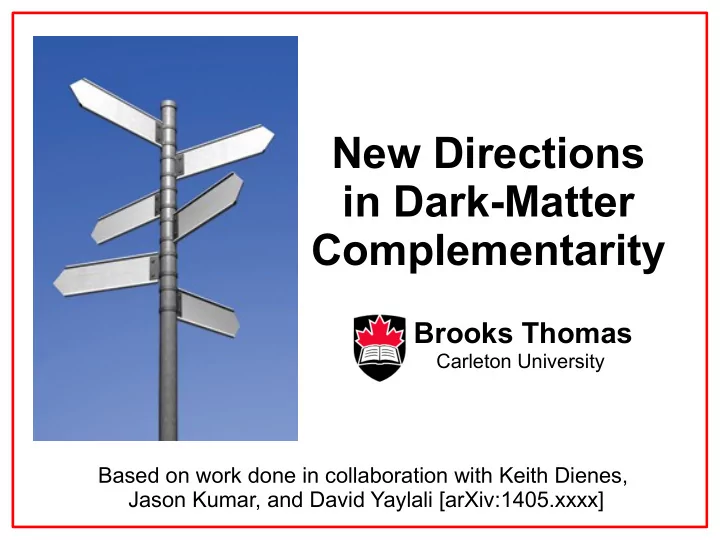

New Directions in Dark-Matter Complementarity Brooks Thomas Carleton University Based on work done in collaboration with Keith Dienes, Jason Kumar, and David Yaylali [arXiv:1405.xxxx]
Complementarity: Collider production The Standard Picture Elastic scattering The Underlying Principle: A single operator which couples DM particles to SM particles generically contributes to a variety of different physical processes. DM Annihilation Two facets of complementarity: ● Coverage : Different detection channels Indirect Detection Overlap are sensitive in different regions of the parameter space of dark-matter models. Direct Direct ● Correlations : Observing signals in detection detection Colliders multiple channels with regions of that parameter space in which sensitivities overlap. DM Parameter Space
Complementarity: A More General Picture In multi-component theories of dark matter, additional physical processes are possible. These include... 1 Dark-matter decay ● Heavier χ i can decay into lighter ones even in the case in which the lightest χ i is stable New directions – literally! due to a symmetry. 2 Inelastic scattering of dark matter off with atomic nuclei ● Upscattering of a ligher χ i into a heavier χ j (prototypical inelastic DM) [Hall, Moroi, Murayama, '97; 'Weiner, Tucker-Smith, '01] ● Downscattering of a heavier, metastable χ i into a lighter χ j (“exothermic” DM). [Finkbein er, Slatyer, Weiner, Yavin, '09; Batell, Pospelov, Ritz, '09; Graham,Harnik, Rajendran, Saraswat, '11] Asymmetric pair-production of χ i and χ j at colliders 3 Coannihilation of χ i and χ j (both in the early universe and today) 4
The Fundamental Interactions → ● At the energy scales |q| < O(100 MeV) relevant for direct detection, ~ interactions between the dark and visible sectors in a wide variety of theories can be modeled as effective contact interactions . [See, e.g., Goodman, Ibe, Rajaraman, Shepherd, Tait, Yu '10] ● As an example, consider a dark sector comprising two Dirac fermions χ 1 and χ 2 , with m 2 > m 1 , whose dominant couplings to the visible sector are to SM quarks: Moreover, for purposes of illustration let's focus on the case in which: ● A single operator with i ≠ j dominates and c ≈ 0 for all operators with i = j. (XY) qij ● The majority of the dark matter is in the metastable state χ 2 – i.e, Ω CDM ≈ Ω 2 . ● The c are O(1) and flavor-universal up to an overall ratio between up- and (XY) qij down-type quarks. And define:
Inelastic Scattering and Direct Detection ● In multi-component scenarios, a variety of processes can contribute to the overall scattering rate at direct-detection experiments: ● Inelastic scattering can have a significant impact on direct detection signals when ∆ m 12 is similar the range of recoil energies to which these experiments are sensitive: Elastic scattering, upscattering, and downscattering have their own distinctive kinematics and contribute to the total recoil-energy spectrum in different ways. Solid lines: upscattering Dashed lines: Ge Target downscattering
Decays and Indirect Detection ● In the ∆ m 12 regime relevant for inelastic DM scattering off nuclei, only photons and neutrinos are accessible in χ 2 → χ 1 + SM decays. ● Even when χ 1 and χ 2 couple primarily to quarks, contributions to the decay width of χ 2 generically arise from diagrams involving virtual quarks/hadrons: Contact Off-shell pion These contributions operators processes can be evaluated, e.g., in Chiral Perturbation theory. ● For example, for scalar (SS) and axial-vector (AA) interactions, we find: Decay-Width Contributions Spectrum peaked in the X-ray for ∆ m 12 ~ O(1-100 keV). Widths constrained by diffuse X-ray data from COMPTEL, HEAO-1, etc.
Interplay Between Detection Channels: Results (Preliminary) (Spin-independent) (Spin-dependent) LUX COUPP-4 LZ-7.2 PICO-250L Current direct-detection limits ATLAS/CMS monojet limit Diffuse XRB limit (HEAO-1) ATLAS mono-W/Z limit Diffuse XRB limit (COMPTEL) Future direct-detection reach
Summary ● In multi-component theories of dark matter, new complementarity relations exist between processes absent in single-component theories. ● In particular, a single interaction between DM and SM particles can contribute to: Absent in single- ● Inelastic scattering at direct-detection experiments component ● Asymmetric dark-matter production at colliders theories! ● Indirect-detection signals due to dark-matter decay ● We have also demonstrated the power of these complementarity relations in covering the parameter space of a toy two-component dark sector. ● In the small-coupling/large- Λ regime, there is significant overlap between the regions excluded by direct- and indirect-detection limits. Together, these complementary probes of the dark sector provide complete coverage of the relevant parameter space in this regime. ● By contrast, in the large-coupling/small- Λ regime, a range of ∆ m 12 opens up for which the dark sector escapes detection. Motivates new detection strategies to “fill the gap.”
Backup Slides
Inelastic Dark Matter: Scattering Kinematics , m 2 = 1 GeV m 2 = 10 GeV m 2 = 100 GeV Signal region Signal region Signal region Upscattering Downscattering (“Funnel”) Downscattering Upscattering ∆ m 12 = 1 keV ∆ m 12 = -1 keV ∆ m 12 = 10 keV ∆ m 12 = -10 keV ∆ m 12 = 100 keV ∆ m 12 = -100 keV
Recommend
More recommend